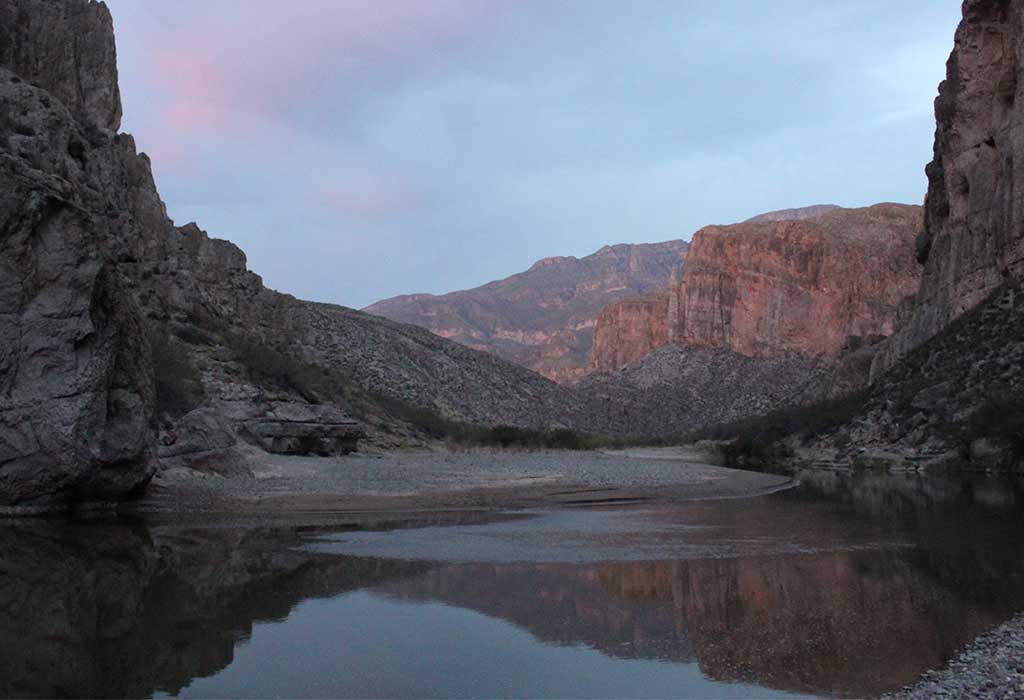As I stood at the edge of the gorge in the heart of the Rio Grande del Norte National Monument in northern New Mexico, I heard a familiar call echo off the canyon walls. The last time I experienced that beautiful cascading series of notes was in a canoe floating the Rio Grande in Big Bend National Park a few months earlier. While these two enchanting landscapes are nearly 800 miles apart, both are home to the understated (but mighty) canyon wren and are bridged by a historically vast but now fading icon of the desert Southwest—the Rio Grande.
Like the wren’s song, the song of the Rio Grande is fading under the forces of nineteenth-century water law, twentieth-century infrastructure, and twenty-first-century population growth and climate change. In the north, the Rio Grande emerged from clear, meandering headwater streams in Colorado to grow strong enough to carve an immense chasm bisecting northern New Mexico. To the south, that same behemoth river (with a flush of water from the Rio Conchos, a major tributary out of Mexico) cut some of the most famous canyons in the Southwest, including Mariscal, Boquillas, and Santa Elena Canyons along the border between the United States and Mexico.
Thanks to Congress 50 years ago, the river, the canyon wrens, and these magical canyons are afforded the protections of the National Wild and Scenic Rivers Act. The act recognizes the unique cultural, historical, scenic, geologic, water quality, fish and wildlife, and recreational values of free-flowing rivers.
The law was conceived after decades of dam building in the first half of the 20th century that brought many of our greatest rivers to their knees, including the Rio Grande. By the time the northern segment of the Rio Grande was named one of eight original wild and scenic rivers in 1968, the river and its tributaries already bore the burden of eight major dams and water storage reservoirs in Colorado, New Mexico, Texas, and Mexico. Many conservation-minded senators had the foresight to introduce a bill that would preserve rivers in their free-flowing condition and protect “their pristine attributes uncontaminated by the invasion of human beings.”
The centerpiece of the law is that it identifies a process for designating unique rivers and their surrounding landscapes and places them off limits to dams and water development projects. Once designated, each river is managed by a federal agency (e.g., the U.S. Bureau of Land Management or National Park Service) with the goal of enhancing and protecting its outstanding values. Former Senator Frank Church, D-Idaho, said it best, when describing the intent of the act, that “[w]ith it, we can save for ourselves and our descendants some of the delight and stimulation former generations have known in America’s unspoiled and unsurpassed wild rivers.”
The act has protected 208 rivers (12,734 miles) in 40 states and Puerto Rico, including two sections (a total of 270 miles) of the Rio Grande (74 miles from the Colorado state line to Rinconada, N.M., and 196 miles from above Mariscal Canyon to the Terrell-Val Verde County line in Texas). Other rivers that enjoy the protections of the act are the Klamath, Snake, and Willamette in Oregon; the Flathead and Missouri in Montana; the Yellowstone and Snake in Wyoming; the Salmon and Snake in Idaho; the Snoqualmie and White Salmon in Washington, and the Rio Chama, Pecos, and Jemez in New Mexico (to name just a few).
The act serves as an important stepping-stone in proactively shielding rivers from harmful development. However, much work remains to be done. The National Wild and Scenic Rivers System protects less than one-quarter of one percent of America’s rivers. An estimated 84,000 dams already modify nearly 600,000 miles (17 percent) of our rivers. Thus, many more of our crown jewel rivers remain at risk. One salient example is the Gila River, the subject of a recurring and foolish effort by the State of New Mexico to dam and divert it for decades. The designation of the Gila as wild and scenic would put to rest the relentless effort to destroy this last free-flowing river in New Mexico.
As I sat and listened to the melody of the canyon wren that day, I felt grounded in two experiences at once—the one I was presently in and the one that is etched in my soul from a few months prior. My experience somehow reconnected the miles between and made me hopeful that, starting with these places, the wild can be restored.
